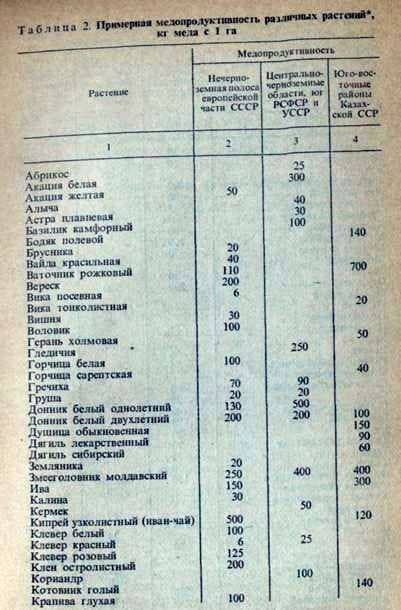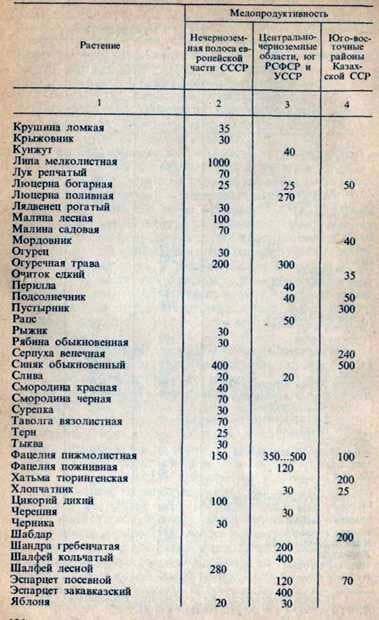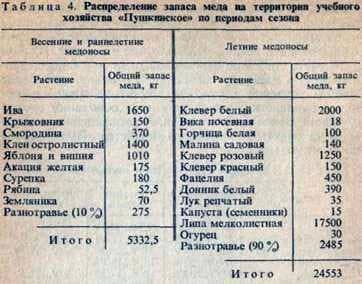The composition of the fodder balance of the apiary

The work on the composition of the feed balance of apiaries is carried out in the following order:
1) take into account the species composition of the major honey plants, growing in the area of useful summer bees of this apiary;
2) determine the areas occupied by the honey plants;
3) calculate the honey reserve area;
4) calculate the number of families that can be provided with honey at a given point.
The first half of the work is carried out in the summer in the field setting, and the calculation of honey reserves and the calculation of families can be made in the winter in laboratory classes. In the case if the work was not carried out during the summer period, on the laboratory classes the areas and inhomogeneous terrain, the species composition of the plants are carried out, the crockiness in turn is subdivided into typical areas. Thus, for a more convenient and more accurate survey, the general massif of the forest is divided into areas with predominance of spruce or thicket of willow, pine or linden, etc. In the meadows, in turn, areas are distinguished with a predominance of white clover in the grass stand, meadows, felling, etc. In the diary, the approximate boundaries of each plot are plotted according to the landmarks on the map and terrain (structures, roads, water barriers, individual trees, etc.).
Accounting for grassy vegetation.
The account of honey grasses on meadows is carried out on accounting areas of 0.25 m2. For this purpose, use a square frame with sides 50 x 50 cm, made of thick wire or wooden slats. The frame is laid on the soil and the number of normally developed plant stems growing on the site is counted. In this case, the number of stems of the predominantly strong honey-plants (white or pink clover, Cyprian, sweet clover, sainfoin, etc.), other melliferous plants (sage meadow, nivian, cornflower, meadow geranium,
To master the methodology, the first 2 … 3 samples are taken together by the whole group with the participation of the teacher. Then take a few samples yourself. Registration sites are taken at equal distance along two diagonals or in checkerboard order.
In the same way, the herbaceous vegetation is surveyed on forest edges, glades, bogs, inconvenient lands and pine forests.
Accounting of trees and shrubs.
Previously, the teacher introduces students to the species composition of trees that occur in the forest. Then each passes the allotted site in one direction, counting (by species) all the trees growing on the 2 m strip to the right and to the left. After completing the route, the student counts the total number of trees encountered and each of the honey-bearing species (linden, maple, willow, white acacia, gladichia, mountain ash) separately. Further calculations of the percentage ratio of honey to the area occupied by them are carried out at the end of the survey. Returning to the starting point, the honey-bearing shrubs (raspberry, buckthorn, honeysuckle, sea buckthorn, yellow acacia, heather) are recorded.
Shrubs are found in the forest as separate clumps, so they are taken into account somewhat differently than the pedigree composition of the trees. To do this, everyone, returning on a forest plot with approximately the same road, takes into account all the honey-bearing bushes on a 2 m wide strip. The passed way is measured in steps, noting at what distance the honey bushes met, how many steps the curtain took and what kind of honey-tree it was, whether it occupied the entire width of the strip or only a part of it. All this information is recorded in a diary.
After completing the route, move the steps to meters and determine the absolute area of the surveyed area (multiplying the total path length by 2). The size and percentage of each honey-bush is then calculated with respect to the total surveyed strip area.
In the same way, the area of honey grasses in the forest is estimated if they are found by separate curtains, rather than by solid masses.
At the end of the survey of each site, each person, on the basis of entries in the diary, calculates the percentage of prevailing and other meadows in meadows, forests and other areas. After that, fill in the summary table and begin to compose the honey balance of the apiary.
Making honey balance beehives. The further course of work is shown on a concrete example.
Calculation of the total stock of honey.
After completing the first three columns of the table with the data obtained from the survey of the terrain, they begin to calculate the total stock of honey in the entire area surrounding the apiary.

So, knowing the size of each site and the percentage composition of the growing honey plants, calculate the absolute area occupied by them. Then fill in the column “Medoproduktivnaya 1 hectare” data taken from Table. 2, and calculate the total stock of honey. In order to more clearly see the relative value for the bees of certain sites and fields, the total reserve of honey is calculated for each site separately, and then the obtained indicators are summarized.
In our example, the total stock of honey is rounded up to 30 000 kg. However, bees can not use it completely. During the flowering period of individual honey-plants, bees often do not fly out of hives due to rainy days or because of unfavorable conditions (wind, high temperature and low relative humidity) can not collect nectar. Part of the nectar is used by other insects. Thus, the share of bees in different zones accounts for 30 to 50% of the total nectar released by plants. In this regard, accordingly, we reduce the stock to 40%. Then the amount of honey attributable to bees in this area is 12,000 kg.
Calculation of the number of families.
Knowing the stock of honey, it is not difficult to calculate how many bee colonies can be provided with food at a given point. It is known that the annual requirement for one family in honey is about 90 kg. Of these, 18 … 20 kg, the beekeeper leaves in the hive during assembly of the nest for the winter, the rest the amount of honey the family collects and consumes during the spring-summer season. In addition, each family should give some amount of marketable honey. Let it be 30 kg in our example. Therefore, for each family we must plan at least 120 kg of honey. Dividing the total stock of honey for the needs of one family, we learn that the honey reserves of the terrain allow you to keep at this point 100 families of bees. However, for the final solution of the problem, it is necessary to analyze the information received in more detail.

When assessing the food base of the apiary, in addition to the general stocks of honey, it is important to know the uniformity of nectar intake during the season and the most productive plants. Usually, in terms of flowering period, nectariferous plants are divided into 4 groups: early spring, spring and early summer, summer, late and autumn. Due to the fact that in the Leningrad Region, a stable warm weather usually begins on June 15, the first two groups of plants can be combined into one – spring and early-year honey-plants and on the basis of the flowering periods given in Table. 3, to distribute the reserves of honey in the territory of the educational enterprise “Pushkin” for the periods of the season.

As can be seen from the data given in Table. 4, the reserves of honey for the spring and early summer are 5332.5 kg, or taking into account 40% of effective collection of nectar – 2133 kg. According to the Institute of Apiculture, one family from the beginning of spring to the second half of June requires about 30 kg of honey. Consequently, 71 families of bees may be in the studied territory during this period. The reserve of honey for the summer period is 24,553 kg or 40% -8821.2 kg. Thus, during the summer period, 98 families of bees could be kept at this point (24553: 90). However, the main nectarone, giving 71% of all honey in the summer, is linden.

Taking the period of its flowering in 12 days and the amount of honey falling to the share of bees (40%), equal to 7000 kg, we could expect a daily increase in the mass of honey from the lime trees in each of the 98 families of almost 6 kg. In fact, the increase in mass from the control hive in the apiary with 35 … 40 families over the last 5 years during the flowering period did not exceed 2 … 3 kg, that is, taking into account 2 times less number of bees was 4 times lower. This is because the plantations in the parks of Pushkin were badly damaged during the Great Patriotic War, and the linden itself in the Leningrad Region is bred only for decorative purposes and, apparently, can not give the same amount of nectar that it stands out in natural conditions habitat.
Thus, with the existing food base and considering that 25 … 30 families of bees are in beekeepers in the same area, it is profitable to keep no more than 35 families at this point, which is actually done. The remaining families are transported to another branch of the economy shortly after wintering.
Analysis of the data given in Table. 1 and 4, indicates that the bribe ends, soon after the flowering of the lime, ie, in late July – early August. After this, you can count only on the aftermath of the white clover and on a small bribe from the phacelia. From this example it is clear that in order to solve the problem of placing the necessary number of families on one or another point, it is important to know well the features of the food base.
However, the overall assessment of honey production by this method is only the first step in this direction. During the analysis of the obtained data it was shown that there can be large deviations both in the direction of overestimation and underestimation of the true value of the calculated honey reserves. In addition, plant nectar production is highly variable depending on meteorological, soil and other conditions. Therefore, in production conditions, it is very important to correct the calculated reserves on the basis of the data of the increase in the weight of the control hive at this point over a number of years and to link with the flowering calendar of the most important nectariferous plants, as provided for in the diary of the control hive.
Based on the indications of the control hive at the end of the year, a duration and bribe strength chart is compiled for different periods of the season at a given point, for which the changes in the mass are recorded on the ordinate axis and the accounting dates on the abscissa. Especially valuable is the generalization of these data over a number of years.
The composition of the fodder balance of the apiary
